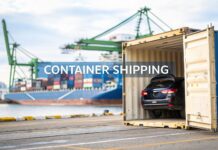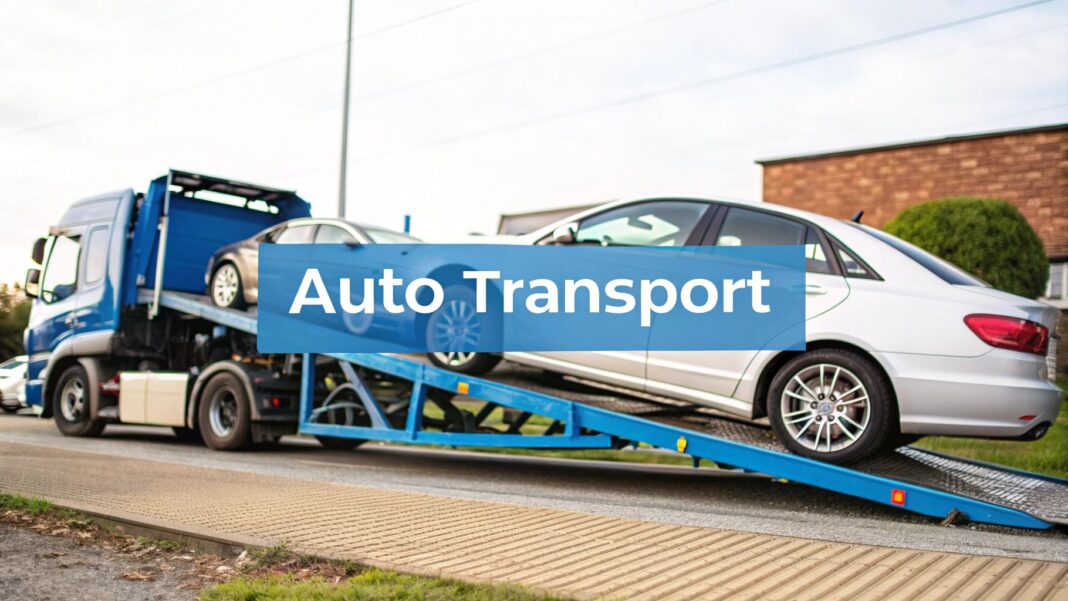
Ever wondered how people move cars across the country without putting a single mile on them? The answer is auto transport by truck. This service involves hiring a professional to haul your vehicle on a specialized carrier, getting it from point A to point B safely and efficiently. This guide provides actionable insights into making the process smooth, affordable, and stress-free.
What Is Auto Transport and How Does It Work
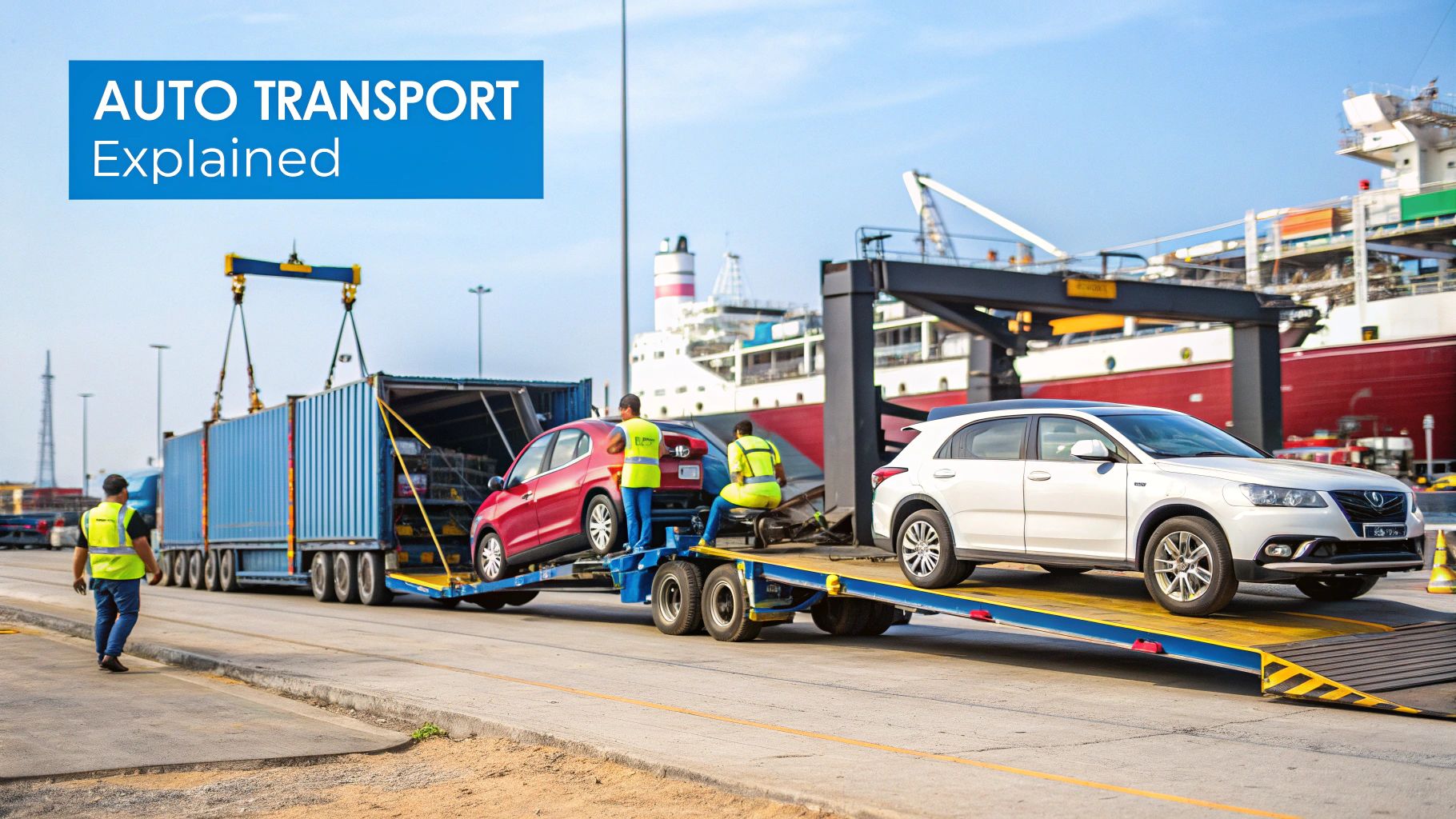
Imagine you're moving from New York to California. You could drive the 3,000 miles, spending money on fuel, lodging, and food, while adding significant wear and tear to your car. The alternative is booking an auto transport by truck. A professional driver loads your vehicle onto a multi-car carrier and manages the entire journey, letting you focus on your move.
This service is not just for relocators. It's a practical solution for snowbirds heading south, classic car collectors purchasing vehicles from out-of-state auctions, and students moving to a distant college.
The Core Process Explained
Shipping your car follows a straightforward process. It begins with requesting a quote, which is calculated based on your route, vehicle type, and preferred shipping dates. Once you approve the quote and book the service, a carrier is scheduled for pickup.
Before loading, the driver conducts a joint inspection with you to document your vehicle's current condition. The car is then securely loaded onto the transport truck.
At its heart, auto transport is a coordination of logistics. It connects vehicle owners with a network of professional truck drivers who specialize in moving cars, ensuring a secure and efficient alternative to a long-distance drive.
During transit, your vehicle is covered by the carrier's cargo insurance, and most companies provide tracking for real-time updates. Upon arrival, you or a designated person will meet the driver, perform a final inspection against the initial report, sign the delivery paperwork, and receive your keys.
Why It's a Practical Choice
Choosing auto transport by truck offers tangible benefits over driving the vehicle yourself, making it a strategically smart decision.
- Saves Time and Reduces Stress: Avoid days of driving fatigue. You can fly to your destination and manage other priorities while your car is professionally transported.
- Protects Your Vehicle: Shipping prevents adding thousands of miles to the odometer and eliminates the risk of road debris, accidents, or mechanical breakdowns during a long trip.
- Cost-Effective Solution: For long distances, the total cost of shipping is often less than the combined expenses of fuel, hotels, meals, and potential maintenance from a cross-country drive. To fully grasp the ins and outs of car transport services and what they entail, it's worth digging into the details.
- Safety and Compliance: Professional auto carriers and their drivers adhere to strict Department of Transportation (DOT) regulations. This includes performing mandatory pre-trip inspections to ensure the truck and all equipment are in safe, working order.
Your Step-by-Step Vehicle Shipping Blueprint
Shipping your car is a manageable process when broken down into clear, actionable steps. Following this blueprint will help you navigate everything from initial quotes to final delivery with confidence.
This flowchart outlines the critical first steps for arranging your vehicle's transport.
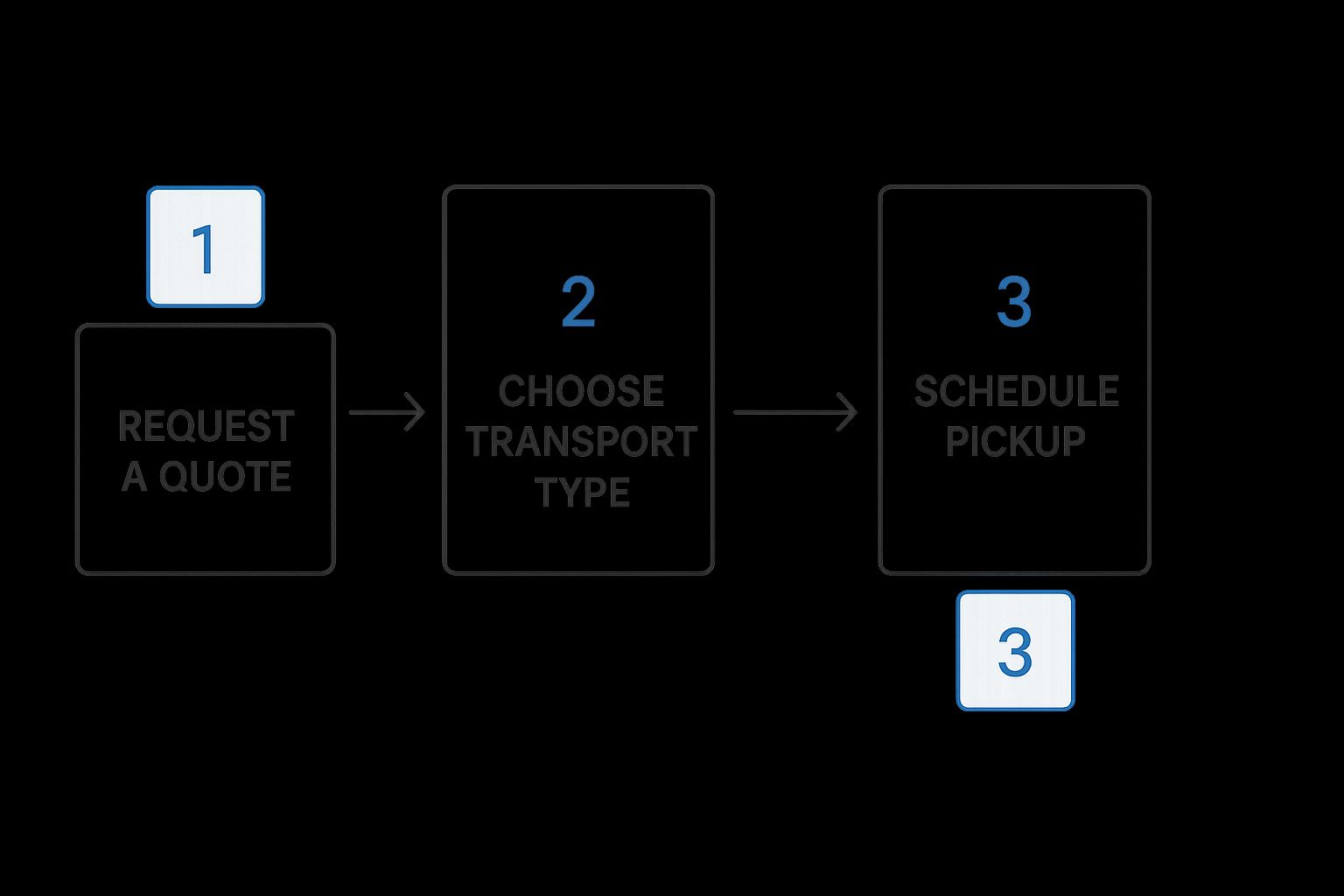
A successful shipment starts with thorough research, leading to an informed decision and finalized logistics.
Step 1: Getting Your Quote
The first actionable step is to gather quotes. To receive an accurate price, have the following information ready:
- Vehicle Information: The year, make, and model.
- Pickup and Delivery Locations: Specific zip codes for an accurate calculation.
- Transport Type: Specify open or enclosed carrier.
- Desired Ship Date: Provide your ideal pickup window.
Obtain quotes from several reputable companies. An unusually low quote can be a red flag for hidden fees or substandard service. Instead of choosing the cheapest, evaluate the overall value, including insurance coverage, customer reviews, and the company's track record.
Step 2: Prepping Your Car for Pickup
Once you've booked your shipment, prepare your vehicle for a smooth and safe handover.
Start by washing your car thoroughly. A clean vehicle makes it easy for you and the driver to accurately document its condition and note any pre-existing scratches or dents on the inspection report.
Next, remove all personal items. Auto transport carriers are not licensed to transport household goods, and their insurance does not cover personal belongings left inside. Excess items also add weight, which can lead to compliance issues for the driver. While some companies might permit one small box in the trunk (check first), the standard rule is to ship the car empty. This is also a good time to consider the added convenience of door-to-door auto transport, which simplifies the logistics.
Pro Tip: Keep the gas tank at about one-quarter full. This is enough fuel for loading and unloading the vehicle but helps minimize the carrier's overall weight, which is a critical safety and regulatory factor.
Finally, document your car's condition by taking clear photos and a short video from all angles, inside and out. This creates a personal record that supplements the official inspection report.
Step 3: The Pickup Day and In-Transit Tracking
On pickup day, you will meet the driver to load your vehicle. The most critical document you will handle is the Bill of Lading (BOL), which serves as both a receipt and a detailed inspection report.
You and the driver will inspect the car together and note any existing damage on the BOL. Review this document carefully before signing. Once signed, your vehicle is officially in the carrier's custody, and you will receive a copy.
During transit, most modern transport companies offer tracking services. This may be through a web portal, a mobile app, or direct communication with the dispatcher, giving you peace of mind and visibility into your car's location.
Step 4: Accepting Your Delivery
The final step is receiving your vehicle. The driver will unload it at the destination, and you will conduct one last inspection.
Use your copy of the BOL to compare the car's condition to the initial report. Check for any new dings, scratches, or other issues. If everything is in order, you will sign the BOL to confirm a successful delivery and pay any outstanding balance. Once complete, you get your keys back, and your car is ready to drive.
Choosing Between Open and Enclosed Carriers
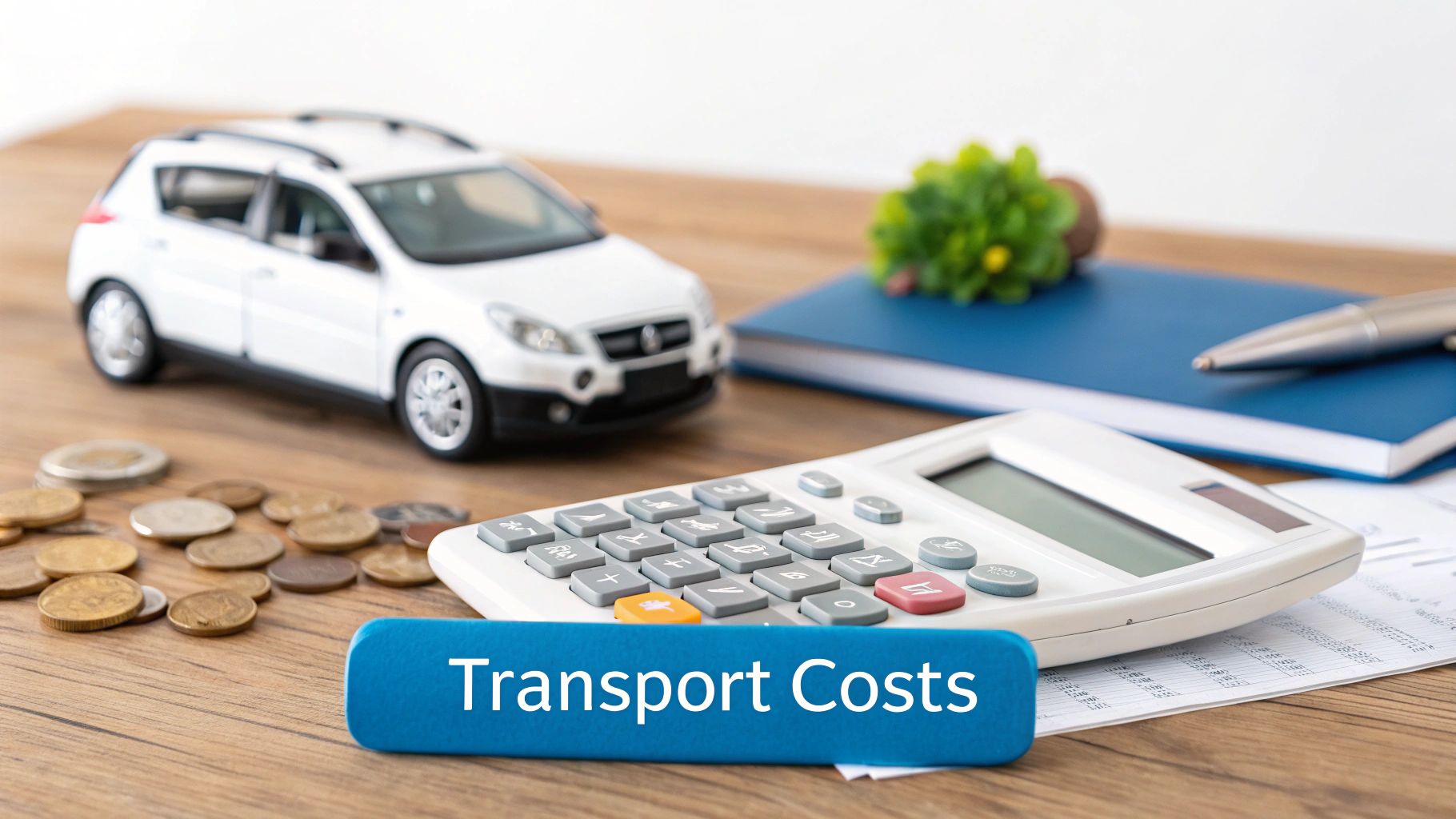
When arranging auto transport by truck, you must choose between an open or an enclosed carrier. This decision impacts cost, protection, and availability. Both methods are safe and reliable, but they cater to different needs and vehicle types.
You've likely seen open carriers on the highway—these are the multi-level trailers carrying up to ten vehicles. They are the most common and cost-effective option, making up the majority of the auto transport fleet. The trade-off is that your vehicle is exposed to weather and road elements, similar to driving it yourself.
Open Carrier Transport: The Industry Standard
For most situations involving a standard sedan, SUV, or minivan, an open carrier is the most practical and economical choice. Because they are so common, you'll find greater availability and more flexible scheduling options.
Open transport is the ideal solution for:
- A family relocating and shipping their daily driver, like a Ford Explorer or Toyota Camry.
- A college student moving a reliable vehicle to campus without a long, solo drive.
- An online car buyer who needs an affordable way to have a recently purchased vehicle delivered from another state.
The sheer volume of vehicles moved this way daily attests to its reliability. To understand the process in more detail, you can explore the specifics of open transport car shipping.
Enclosed Carrier Transport: Maximum Protection
If an open carrier is economy class, an enclosed carrier is a first-class private suite. These trucks have hard or soft-sided walls that completely protect your vehicle from weather, dust, and road debris. This premium service offers the highest level of security.
This level of protection comes at a higher price, typically 30% to 60% more than an open carrier. This is because enclosed trailers accommodate fewer vehicles, and the specialized equipment and handling require a higher service fee.
An enclosed carrier isn't just about protection; it's about peace of mind. It’s a specialized service designed for vehicles where preserving pristine condition is the top priority.
This white-glove service is essential for:
- Luxury and Exotic Cars: Vehicles like a Ferrari, Bentley, or high-end Tesla require protection from any potential cosmetic damage.
- Classic and Antique Vehicles: A restored 1957 Chevrolet Bel Air or a vintage Porsche must be shielded from the elements to preserve its condition and value.
- Race Cars and Custom Builds: Vehicles with low ground clearance or unique dimensions often need the hydraulic lift gates and specialized securing equipment found only on enclosed carriers.
Open vs Enclosed Carrier At a Glance
This table provides a clear, side-by-side comparison to help you make an informed decision based on your specific needs and budget.
| Feature | Open Carrier Transport | Enclosed Carrier Transport |
|---|---|---|
| Cost | More affordable, budget-friendly | Premium price (30-60% more) |
| Protection | Exposed to weather & road debris | Fully protected from all elements |
| Capacity | Up to 10 vehicles per truck | 1-7 vehicles per truck |
| Availability | High availability, easier to book | Less common, may require more lead time |
| Best For | Daily drivers, standard cars, SUVs | Luxury, classic, exotic & custom cars |
| Equipment | Standard ramps for loading | Often has hydraulic lift gates for low cars |
The right choice depends on balancing your vehicle's value with your budget. For a standard daily driver, an open carrier is a perfectly safe and economical option. For a high-value or irreplaceable vehicle, the extra investment in enclosed transport is a wise choice.
Understanding What Drives Your Shipping Cost
The quote you receive for auto transport is not arbitrary; it's calculated based on several key factors. Understanding these variables will help you interpret your quote and identify potential cost-saving opportunities.
The primary factor is distance. A cross-country shipment from Miami to Seattle will cost more in fuel, driver hours, and tolls than a regional move from Atlanta to Nashville. However, the specific route is also critical. Transporting between major metropolitan hubs along established interstate routes is generally cheaper than shipping to or from a remote, rural location that requires a significant detour.
How Your Vehicle's Profile Affects the Price
Your vehicle’s specifications directly impact the cost. Carriers have strict limits on the total weight and space available on each truck.
The size and weight of your car are crucial. A large SUV like a Chevrolet Tahoe or a pickup truck like a Ram 1500 occupies more space and adds more weight than a compact sedan like a Honda Civic. This reduces the number of vehicles a carrier can transport in a single load, so the cost for larger vehicles is higher.
Every car shipment is a balance of space, weight, and distance. The carrier is managing a finite amount of room and a strict weight limit, and your vehicle's characteristics determine how much of that valuable capacity it consumes.
As discussed, your choice of carrier type is a major cost driver. An enclosed carrier provides superior protection but costs 30-60% more than a standard open carrier due to specialized equipment and lower capacity.
The Less Obvious Cost Influencers
Beyond distance, vehicle size, and carrier type, several other factors can influence your final price.
Operable vs. Inoperable: If your vehicle cannot run, steer, and brake on its own, it is considered inoperable. Loading an inoperable vehicle requires a winch and additional labor, which will incur an extra fee (typically $150-$250).
Seasonality: The auto transport industry experiences peak seasons. Summer is a popular time for moving, and late fall sees a surge of "snowbirds" shipping their cars south for the winter. This high demand leads to higher prices. If your timeline is flexible, shipping during off-peak months like early spring or late fall can result in lower costs.
Understanding these factors empowers you to make smarter decisions. To estimate your potential costs, you can use a shipping cost predictor tool. This allows you to see how different variables might affect your budget before you start gathering official quotes.
How Technology Is Reshaping Auto Transport
The auto transport industry is undergoing a significant technological transformation, making the process more efficient, transparent, and sustainable. These advancements impact everything from how you get a quote to how your vehicle is tracked across the country.
What was once an industry reliant on phone calls and faxes has shifted to digital platforms. Today, you can get instant online quotes, book shipments with a few clicks, and track your vehicle’s journey in real-time from your smartphone, providing a level of transparency that was previously unavailable.
The Rise of Smart Logistics
At the core of this evolution is advanced logistics software, often enhanced with artificial intelligence (AI). This technology acts as a central command center for entire fleets, optimizing routes and schedules by analyzing numerous variables simultaneously.
This software processes:
- Real-time traffic data to avoid congestion and delays.
- Weather patterns to bypass severe storms.
- Fluctuating fuel prices to identify the most economical routes.
- Pickup and delivery locations to build the most efficient multi-car loads.
This high level of optimization allows carriers to maximize efficiency, reducing transit times and fuel consumption. For customers, this means more accurate delivery estimates, better communication, and more competitive pricing. Data-driven logistics is replacing outdated manual planning.
The use of AI and machine learning isn't just a minor tweak; it's a complete overhaul of the industry's logistical backbone. The result is a system you can actually rely on to be more efficient and predictable.
A Greener Approach to Hauling
The industry is also making significant strides toward sustainability. Environmental responsibility is becoming a key focus, with investments in greener technologies and more efficient operational practices.
The trucking industry is a major economic force, with a global market value projected to be around $2.2 trillion by 2025. This sector is now embracing electrification, with the electric truck market expected to grow from $5.92 billion in 2025 to $38.76 billion by 2032.
While diesel remains dominant, efficiency is a top priority, with over 60% of fleets using optimization software reporting reduced emissions. Major companies like Amazon and Walmart are integrating electric trucks into their logistics networks, signaling a broader shift. You can read more about these major trucking industry shifts and their economic and environmental impact.
This focus on green technology aims to build a more resilient and responsible industry. As battery technology improves and charging infrastructure expands, electric auto carriers will become more common, making auto transport a cleaner service.
Got Questions? We've Got Answers
Even with a clear plan, you may still have questions about the auto transport process. Here are answers to some of the most common inquiries.
How Long Does It Really Take to Ship a Car?
Transit time is primarily determined by distance. While exact timing can vary, these general timeframes can help you plan:
- Shorter, regional hauls (under 500 miles): Typically 1-3 days.
- Coast-to-coast trips (over 2,000 miles): Usually takes 7-10 days.
It's important to understand that you will be given a delivery window, not a precise appointment. The driver is coordinating multiple pickups and drop-offs, and factors like traffic, weather, and other logistical variables can affect the schedule. Flexibility is key.
Is My Car Covered by Insurance During Transit?
Yes, absolutely. Federal law requires all licensed and bonded auto carriers to maintain a cargo insurance policy. This policy protects your vehicle against damage caused by carrier negligence during transport.
Before you commit to anything, always ask for a copy of the company's Certificate of Insurance. This isn't just a suggestion—it's a crucial step for your own peace of mind. It's the proof that your car is actually protected.
Remember that the Bill of Lading (BOL) is your most important document. The detailed inspection report you complete with the driver at pickup serves as the official record of your car's pre-shipment condition and is essential for filing a claim if necessary.
Can I Pack My Car with Personal Stuff?
The standard industry rule is no. You should plan to ship your vehicle completely empty of personal belongings. Auto transport companies are licensed to transport vehicles only, not household goods, and their cargo insurance does not cover personal items.
There is also a safety and regulatory reason for this policy. Extra weight can affect the truck's balance and may cause the carrier to exceed federal weight limits. While a few carriers may permit a single box in the trunk (often for an extra fee), it's best to assume the car must be empty. Always confirm the company's specific policy before pickup.
Ready to ship your vehicle with confidence? The team at We Will Transport It has over a decade of experience managing every detail of the auto transport process. Get your free, no-obligation quote today and let our logistics experts ensure your car arrives safely and on time. Visit us at https://www.wewilltransportit.com to get started.




